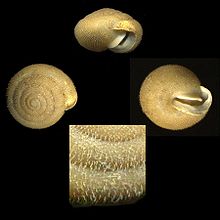
Franklin County is a county along the Gulf of Mexico in the panhandle of the U.S. state of Florida. As of the 2020 census, the population was 12,451, making it the third-least populous county in Florida. The county seat is Apalachicola.

Apalachicola is a city and the county seat of Franklin County, Florida, United States, on the shore of Apalachicola Bay, an inlet of the Gulf of Mexico. The population was 2,341 at the 2020 census.

The Apalachicola-Chattahoochee-Flint River Basin is the drainage basin, or watershed, of the Apalachicola River, Chattahoochee River, and Flint River, in the Southeastern United States.

The Apalachicola River is a river, approximately 160 miles (260 km) long, in the state of Florida. The river's large watershed, known as the Apalachicola, Chattahoochee and Flint (ACF) River Basin, drains an area of approximately 19,500 square miles (50,500 km2) into the Gulf of Mexico. The distance to its farthest head waters in northeast Georgia is approximately 500 miles (800 km). Its name comes from Apalachicola Province, an association of Native American towns located on what is now the Chattahoochee River. The Spanish included what is now called the Chattahoochee River as part of one river, calling all of it from its origins in the southern Appalachian foothills down to the Gulf of Mexico the Apalachicola.
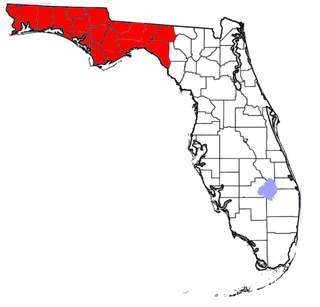
The Florida panhandle is the northwestern part of the U.S. state of Florida. It is a salient roughly 200 miles (320 km) long, bordered by Alabama on the north and the west, Georgia on the north, and the Gulf of Mexico to the south. Its eastern boundary is arbitrarily defined. It is defined by its southern culture and rural geography relative to the rest of Florida, as well as closer cultural links to French-influenced Louisiana, Mississippi, and Alabama. Its major communities include Pensacola, Navarre, Destin, Panama City Beach, and Tallahassee.

Torreya State Park is a 13,735 acre (56 km2) Florida State Park, United States National Natural Landmark and historic site thirteen miles (19 km) north of Bristol. It is located north of S.R 12 on the Apalachicola River, in northwestern Florida, at 2576 N.W. Torreya Park Road.
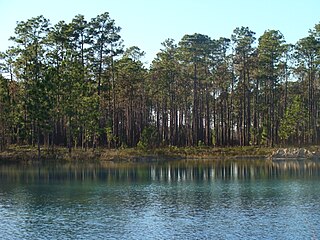
The Apalachicola National Forest is the largest U.S. National Forest in the state of Florida. It encompasses 632,890 acres and is the only national forest located in the Florida Panhandle. The National Forest provides water and land-based outdoors activities such as off-road biking, hiking, swimming, boating, hunting, fishing, horse-back riding, and off-road ATV usage.

Tate's Hell State Forest is 202,000 acres (819 km2) of land in Franklin and Liberty counties in Florida. The forest is located near Carrabelle off US 98 along the Gulf coast and on St. James Island. At one time, Tate's Hell supported at least 12 major habitats including: wet flatwoods, wet prairie, seepage slope, baygall, floodplain forest, floodplain swamp, basin swamp, upland hardwood forest, sandhill, pine ridges, dense titi swamp thickets and scrub. Tate's Hell State Forest is an important hydrologic area and includes a section of the New River. The park's watershed provides fresh water into the Apalachicola Bay, the Carrabelle River and the Ochlockonee River.
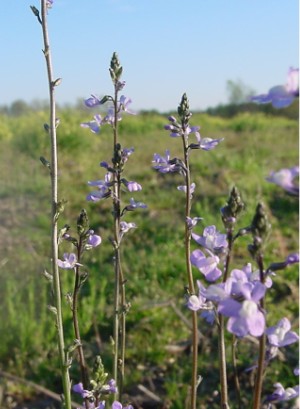
Nuttallanthus is a genus of four species of herbaceous annuals and perennials that was traditionally placed in the foxglove family Scrophulariaceae. Due to new genetic research, it has now been placed in the vastly expanded family Plantaginaceae. Three species of Nuttallanthus are native to North America and one to South America. Nuttallanthus was until the 1980s included in a wider circumscription of the genus Linaria, a genus now considered restricted to the Old World.

George Sydney Hawkins was a US Representative from Florida. Born in Kingston, Ulster County, New York; attended the common schools and was graduated from Columbia University, New York City; studied law; was admitted to the bar and practiced; moved to Florida and settled in Pensacola, Florida; served as captain in the Indian war of 1837; member of the Legislative Council of the Territory of Florida; appointed district attorney in 1841; appointed United States district attorney for the Apalachicola district in Florida in 1842; associate justice of the Florida Supreme Court 1846–1850; elected judge of the circuit court in January 1851; member of the Florida House of Representatives; served in the Florida State Senate; collector of customs for the port of Apalachicola; elected as a Democrat to the Thirty-fifth and Thirty-sixth Congresses and served from March 4, 1857, to January 21, 1861, when he withdrew; judge of the district court under the Confederate Government 1862–1865; commissioned by the legislation of 1877 to prepare a digest of the State laws of Florida.

Apalachicola Bay is an estuary and lagoon located on the northwest coast of the U.S. state of Florida. The Apalachicola Bay system also includes St. George Sound, St. Vincent Sound and East Bay, covering an area of about 208 square miles (540 km2). Four islands, St. Vincent Island to the west, Cape St. George Island and St. George Island to the south, and Dog Island to the east, separate the system from the Gulf of Mexico. Water exchange occurs through Indian Pass, West Pass, East Pass and the Duer Channel. The lagoon has been designated as a National Estuarine Research Reserve and the Apalachicola River is the largest source of freshwater to the estuary. Combined with the Chattahoochee River, Flint River, and Ochlockonee River they drain a watershed of over 20,000 square miles (50,000 km2) at a rate of 19,599 cubic feet per second according to the United States Geological Survey in 2002.
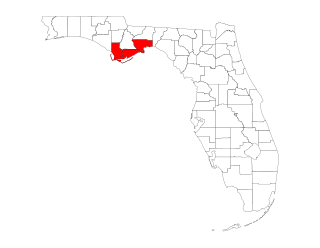
The Forgotten Coast refers to a largely undeveloped and sparsely populated coastline in the panhandle of the US state of Florida. The trademarked term was first used in 1992, but the Forgotten Coast's exact extent is not agreed upon.
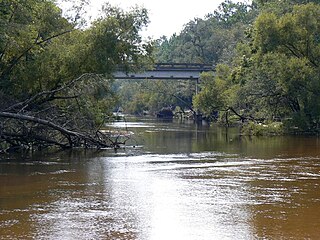
The Ochlockonee River is a fast running river, except where it has been dammed to form Lake Talquin in Florida, originating in Georgia and flowing for 206 miles (332 km) before terminating in Florida.

Alvan Wentworth Chapman was an American physician and pioneering botanist in the study of flora of the American Southeast. He wrote Flora of the Southern United States, the first comprehensive description of U.S. plants in any region beyond the northeastern states.
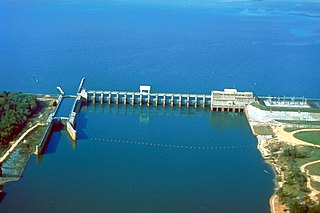
Lake Seminole is a reservoir located in the southwest corner of Georgia along its border with Florida, maintained by the U.S. Army Corps of Engineers. The Chattahoochee and Flint rivers join in the lake, before flowing from the Jim Woodruff Lock and Dam, which impounds the lake, as the Apalachicola River. The lake contains 37,500 acres (152 km2) of water, and has a shoreline of 376 mi (605 km). The fish in Lake Seminole include largemouth bass, crappie, chain pickerel, catfish, striped bass and other species. American alligators, snakes and various waterfowl are also present in the lake, which is known for its goose hunting.
Apalachicola Province was a group or association of towns located along the lower part of the Chattahoochee River in present-day Alabama and Georgia. The Spanish so called it because they perceived it as a political entity under the leadership of the town of Apalacicola. It is believed that before the 17th century, the residents of all the Apalachicola towns spoke the Hitchiti language, although other towns whose people spoke the Muscogee language relocated among the Apalachicolas along the Chattahoochee River in the middle- to later- 17th century. All of the Apalachicola towns moved to central Georgia at the end of the 17th century, where the English called them "Ochese Creek Indians". They moved back to the Chattahoochee River after 1715, with the English then calling them "Lower Creeks", while the Spanish called them "Ochese".

Jim Woodruff Dam is a hydroelectric dam on the Apalachicola River, about 1,000 feet (300 m) south of that river's origin at the confluence of the Flint and Chattahoochee Rivers.

Conradina glabra is a rare species of shrub known by the common names Apalachicola rosemary or Apalachicola false rosemary. It is endemic to Liberty County, Florida, where it is known from about ten populations. It is found only in a small area and it is threatened by habitat destruction. It is a federally listed endangered species.
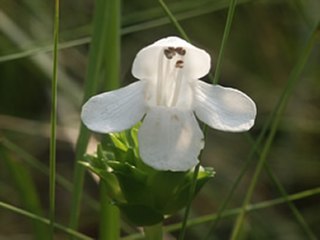
Macbridea alba is a rare species of flowering plant in the mint family known by the common name white birds-in-a-nest. It is endemic to Florida in the United States, where it is found in four counties in the Florida Panhandle. It is threatened by the loss and degradation of its habitat, and it is federally listed as a threatened species of the United States.
Boltonia apalachicolensis, common name Apalachicola doll's-daisy, is a North American species of plants in the family Asteraceae. It is found in the "panhandle" region of northwestern Florida, and has been found in south Louisiana, and Mississippi in the United States.
